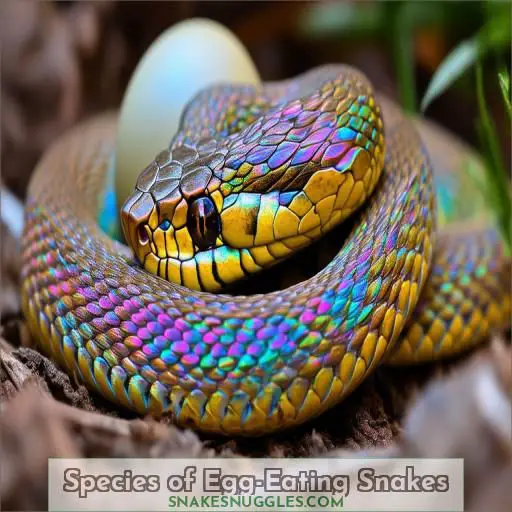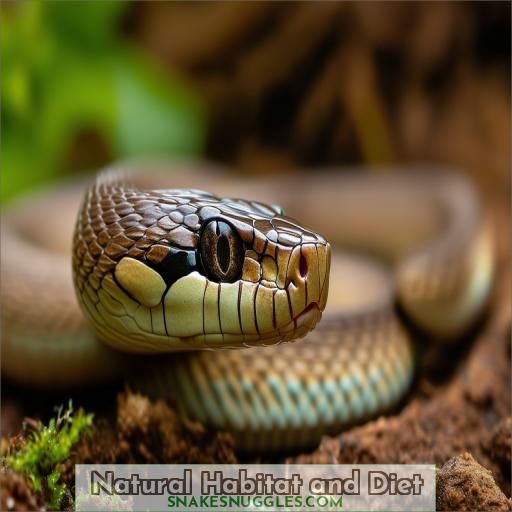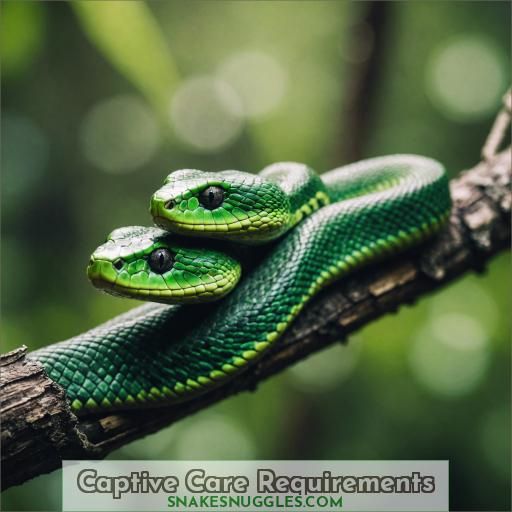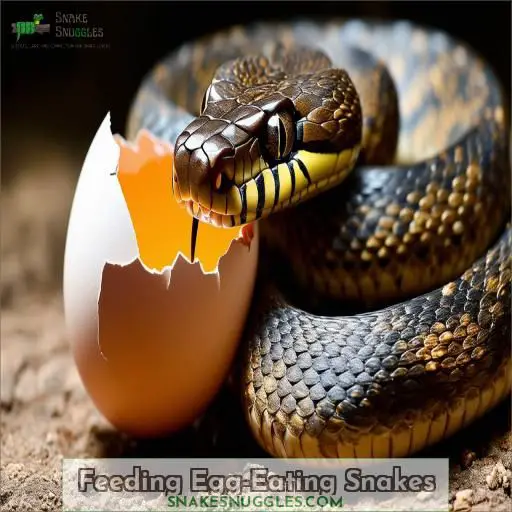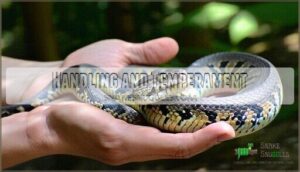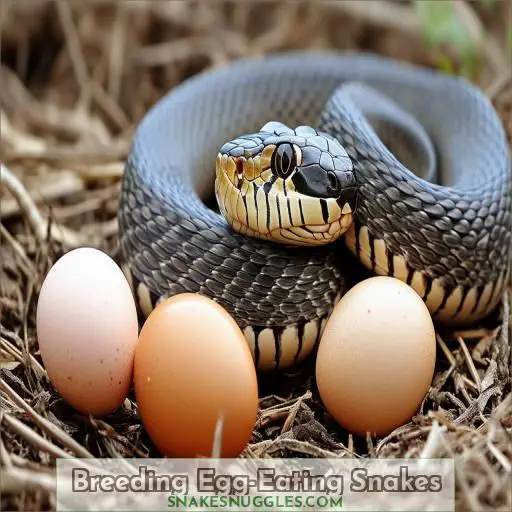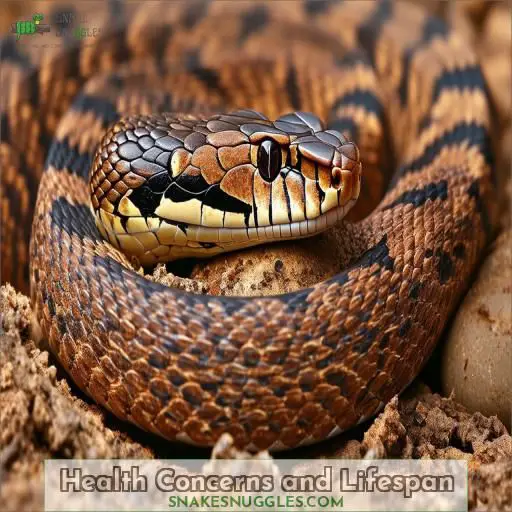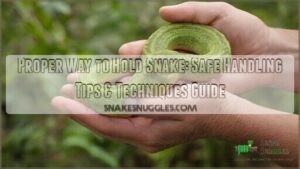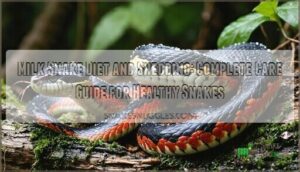This site is supported by our readers. We may earn a commission, at no cost to you, if you purchase through links.
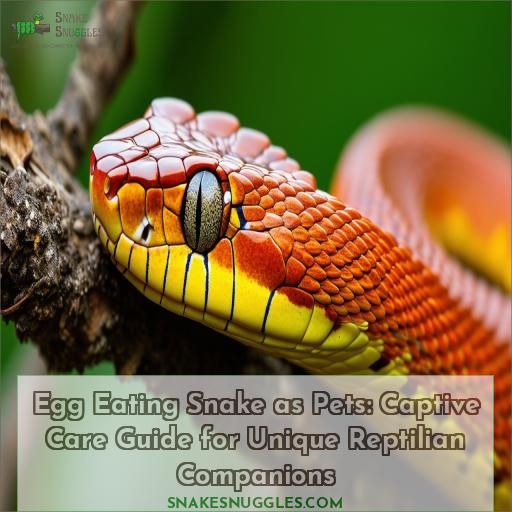 Egg-eating snakes make unique but challenging pets, requiring specialized care suited for experienced reptile enthusiasts.
Egg-eating snakes make unique but challenging pets, requiring specialized care suited for experienced reptile enthusiasts.
You’ll need to nail their specific enclosure needs, like precise temperature and humidity levels.
While providing an exclusive diet of bird eggs.
Their specialized anatomy, like toothed jaws for slicing eggshells, demands careful handling too.
Though extremely rewarding for the right owner, these dexterous serpents aren’t ideal for beginners.
But if you’re prepared to meet their unique requirements, they offer a fascinating glimpse into the remarkable evolutionary adaptations of these unusual egg-eaters.
That’s just scratching the surface – keep going to uncover their extraordinary world.
Table Of Contents
- Key Takeaways
- Egg-Eating Snake Overview
- Species of Egg-Eating Snakes
- Natural Habitat and Diet
- Captive Care Requirements
- Feeding Egg-Eating Snakes
- Handling and Temperament
- Breeding Egg-Eating Snakes
- Health Concerns and Lifespan
- Suitability as Pets
- Where to Find Egg-Eating Snakes
- Frequently Asked Questions (FAQs)
- Do egg-eating snakes make good pets?
- What pet snakes only eat eggs?
- How to care for an egg-eating snake?
- Are egg-eating snakes venomous?
- Are egg-eating snakes legal to own everywhere?
- How do you introduce live eggs safely?
- Can egg-eating snakes cohabitate with other species?
- What type of eggs are easiest to source?
- Conclusion
Key Takeaways
- These slinkyserpents are a real handful, requiring the dedication of a seasoned reptile whisperer – not quite the scaled sidekick for a newbie!
- It’s like sourcing the holy grail of snack foods – tracking down a steady supply of appropriately-sized eggs from various avian amigos to keep these peckish predators content. Let’s just say, your local grocery store won’t cut it!
- Imagine a cryptkeeper’s lair, but make it chic – reconstructing their precise environmental conditions is a delicate dance between maintaining the right temperatures, humidity levels, and atmospheric vibes. One misstep, and you might hatch an unhappy camper!
- While watching these dexterous egg executioners in action is wildly fascinating, their handling preferences range from enthusiastic cuddlers to temperamental divas. Approach with caution and respect their personal space, unless you want to become an impromptu omelet station!
Egg-Eating Snake Overview
Egg-eating snakes, an enthralling group within the serpent world, have evolved an extraordinary adaptation – their sole diet consists of eggs from various bird species.
Belonging to the Dasypeltis genus, these unique reptiles possess specialized tooth-bearing spines capable of tearing through eggshells.
Despite their peculiar feeding habits, egg-eaters play a crucial role in ecological balance, regulating bird populations.
Notably, these snakes exhibit diverse sizes, ranging from slender to robust forms, hinting at their evolutionary journey across different geographic regions.
Although non-venomous, egg-eaters have developed remarkable egg-extracting techniques, making them captivating subjects for reptile enthusiasts yearning to explore nature’s marvels.
Species of Egg-Eating Snakes
The two main species of egg-eating snakes kept as pets are the Indian egg-eater (Montypythonoides phayrei) and various species from the genus Dasypeltis, collectively known as egg-eating snakes. These unique reptiles have evolved specialized traits, such as tooth modifications and jaw mobility, to consume eggs as their primary diet.
Indian Egg-Eater
The Indian egg-eater (Elachistodon westermanni), also called the Indian snake-egg-eating snake, is a fascinating species endemic to India. These snakes are so specialized that they swallow eggs whole, using their powerful jaws and unique anatomical adaptations to crush the eggs internally. They prefer sandy substrates and drink water from bowls or misting.
Dasypeltis Snakes
You’re likely more familiar with dasypeltis species, comprising:
- Egg-eating snakes from Africa.
- Unusual dentition for consuming eggs whole.
- Inoffensive, though some secrete mild venom.
- Gaining popularity in the exotic pet trade.
These snakes thrive on a diet of quail eggs, basking temperatures around 90°F, and sandy soil with appropriate décor mimicking their natural habitat. Captive care requires specialized knowledge but rewards with a unique pet experience.
Natural Habitat and Diet
These snakes hail from sub-Saharan Africa.
They sport slender bodies, rounded heads, and keeled scales for gripping eggs.
In their natural habitat, they feast exclusively on bird eggs of varying sizes.
They use specialized tactics like sawing through shells with razor-sharp teeth and alternating muscle contractions to swallow eggs whole.
Captive breeding has helped meet demand while reducing strain on wild populations.
However, mimicking their precise dietary needs poses challenges regarding egg size, freshness, and nutritional balance – crucial factors impacting long-term health and ethical treatment as pets.
Captive Care Requirements
When setting up the enclosure for an egg-eating snake, proper temperature and humidity levels are essential. You’ll need to provide a basking area of 95-100°F, a cool side around 72-82°F, and maintain a humidity level between 40-60% to mimic their natural environment.
Enclosure Setup
To properly house egg-eating snakes, provide a front-opening terrarium (at least 36"L x 18"W x 36"H) with secure ventilation. Opt for naturalistic decor placement while ensuring proper UVB lighting, basking spots, and a large water bowl. Substrate choice impacts humidity levels, so monitor closely.
Temperature and Humidity
You’ll need to provide a temperature gradient with a basking area around 95-100°F and a cool end near 75°F. Maintain humidity levels around 40-60% by misting regularly or using a humid hide box. Proper heating and humidity are essential for these specialized egg-eaters.
Substrate and Hides
You’ll need a 2" substrate depth. Use 1) Zoo Med ReptiSand, 2) Exo Terra Desert Sand, or 3) 60% sand/40% soil mix. Provide 4) cork flats/tubes, caves/hides for hiding spots. Monitor substrate moisture and compaction.
Feeding Egg-Eating Snakes
When feeding egg-eating snakes in captivity, it’s essential to provide the appropriate egg types and sizes that mimic their natural prey. Offering a variety of egg types such as quail, button quail, finch, canary, budgie, and lovebird eggs, ranging from the size of the snake’s head to three times its size, guarantees proper nutrition and contentment.
Egg Types and Sizes
You’ll need a variety of egg types like quail, finch, or button quail eggs. Vary the sizes, but avoid eggs larger than the snake’s head. Properly sized eggs guarantee proper nutrition without complications like egg binding. Egg availability and preparation are essential for these specialized reptiles.
Feeding Frequency
You’ll typically need to feed egg-eaters 1-3 appropriately sized eggs every 7-10 days, adjusting based on their age and activity levels. Provide a variety of fresh, nutritious avian eggs like quail, finch, or budgie for ideal health.
Potential Feeding Issues
You may encounter feeding issues like incorrect egg size, infrequent feedings leading to nutritional deficiencies, or egg availability issues. Monitor closely, adjust as needed, and seek veterinary care if concerns arise. Proper egg-eating snake captive care requires diligence.
Handling and Temperament
In the realm of handling, egg-eating snakes possess a slender build and small rounded head, enabling effortless grasping.
Their disposition varies – some tolerate regular handling well if familiarized early, while others prefer minimal contact.
Proper techniques involving supporting their body and avoiding forceful restraint foster trust for positive interactions.
With a suitably sized enclosure and patient approach, you can delight in observing these unique serpents’ intrinsic behaviors.
However, egg-eaters bred in captivity may be more accustomed to human presence than specimens sourced from the wild.
Breeding Egg-Eating Snakes
If you’re interested in breeding your egg-eating snakes, prepare for a rewarding yet challenging experience.
Research their natural breeding season and provide appropriate temperature and humidity cues.
Use leaf litter and live or artificial plants for egg deposition sites.
Incubate eggs using a method like Zoo Med ReptiSoil in a humid hide or containers with damp vermiculite.
Care for hatchlings in enclosures with cork flats and proper hides.
Breeding introduces genetic variation but requires sourcing appropriate egg sizes and types.
With diligence, you can produce captive-bred offspring while responsibly reducing demands on wild egg resources.
Health Concerns and Lifespan
You’ll want to closely monitor your egg-eating snake’s health. Here are four key areas to focus on:
- Egg Quality: Ensure a varied diet of properly-sized eggs from different bird species to prevent nutrient deficiencies.
- Diet Supplementation: Provide calcium and vitamin D3 supplements, as eggs alone may lack essential nutrients.
- Veterinary Care: Have an experienced reptile vet on hand to address any potential health issues promptly.
- Environmental Factors: Use appropriate lighting (like the Arcadia ShadeDweller UVB kit), heating (halogen flood bulbs or ceramic heat emitters), and monitor humidity levels to maintain ideal conditions.
With proper care and a keen eye on their large, vertical-pupiled eyes, these snakes can thrive for 15-20 years in captivity. Regular health checks are imperative for their longevity.
Suitability as Pets
You should weigh the pros and cons of owning an egg-eating snake as a pet. Factoring in their specialized diet and tendency to be nippy handlers, these unique snakes are better suited for experienced reptile enthusiasts.
Pros and Cons
While captive egg-eating snakes make fascinating pets, they require specialized care. Acquiring legal permits and finding experienced vets may pose challenges. Providing enrichment like hiding spots and varied egg types is essential for their well-being. Understanding their shedding process and avoiding cohabitation is paramount. With dedication, these unique reptiles can thrive in captivity.
Experience Level Required
As egg-eating snakes have specialized diets and care requirements, they’re not recommended for first-time reptile owners. Feeding challenges with obtaining appropriately-sized eggs and handling difficulties due to their defensive nature make them better suited for experienced keepers. If you’re a novice, consider starting with a more beginner-friendly species until you’ve gained the necessary skills and knowledge.
Where to Find Egg-Eating Snakes
Finding egg-eating snakes can be a challenge, but with some persistence, you’ll have success. Here are a few options to explore:
- Online reptile retailers
- Local reptile expos and shows
- Specialized breeders through online forums
- Reptile adoption agencies or rescues
These unique serpents are less common in the pet trade, so you may need to broaden your search. Reputable online retailers can ship captive-bred specimens, while local breeders offer a more personal experience. Adoption is also an option for rehoming egg-eaters in need of new homes. With diligence and the right connections, you can source a healthy egg-eating snake to welcome into your reptile family.
Frequently Asked Questions (FAQs)
Do egg-eating snakes make good pets?
You’ll want to carefully consider if egg-eating snakes are suitable pets. While fascinating, their specialized diet of fresh eggs can be challenging to provide consistently. With proper research and commitment, some keepers find them rewarding, but they may not be ideal for beginners.
What pet snakes only eat eggs?
Egg-eating snakes, like the Indian egg-eater and the rarer South American egg-eater, solely consume eggs in captivity. While unique, their specialized diet requires diligent egg sourcing and careful husbandry to thrive as pets.
How to care for an egg-eating snake?
Like raising dragons, keeping egg-eating snakes captive is no easy feat. Provide a spacious, thoughtfully maintained habitat with precise temperatures, humidity levels, and a steady supply of varied egg sizes for their exclusive diet. Expect challenges, but revel in the uniqueness of these peculiar pets.
Are egg-eating snakes venomous?
Egg-eating snakes are non-venomous constrictors that subdue their egg prey through coiling. You needn’t worry about venomous bites when handling these specialized serpents. Their unique dietary needs make them an advanced captive species, best for experienced reptile enthusiasts.
Are egg-eating snakes legal to own everywhere?
In most regions, egg-eating snakes are legally owned as pets. However, some areas restrict ownership due to conservation concerns or misclassification as dangerous wildlife. Researching local laws before obtaining one guarantees compliance and responsible pet keeping.
How do you introduce live eggs safely?
To introduce live eggs safely, place them in the enclosure when your snake is actively hunting. Use a feeding tong to gently move the egg near your snake’s nose and let its natural predatory instincts take over. Never leave eggs unattended to avoid contamination.
Can egg-eating snakes cohabitate with other species?
Imagine a lion sharing its den with a gazelle – it simply wouldn’t work. Egg-eating snakes are solitary hunters that can’t cohabitate safely with any other species due to their specialized dietary needs and predatory nature. For their well-being, they must be housed individually.
What type of eggs are easiest to source?
For egg-eating snakes, the easiest eggs to source are quail, finch, and button quail eggs. These eggs are readily available at most pet stores and online reptile suppliers.
Conclusion
Like the enigmatic egg-eating snakes that have evolved intricate adaptations, your decision to keep these specialized reptiles as pets demands unwavering commitment.
While challenging, these dexterous serpents offer a compelling window into nature’s marvels for the experienced reptile enthusiast.
With careful care and adherence to their exacting needs, you’ll be rewarded by the extraordinary sight of an egg-eating snake thriving in captivity.


